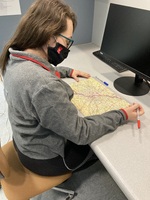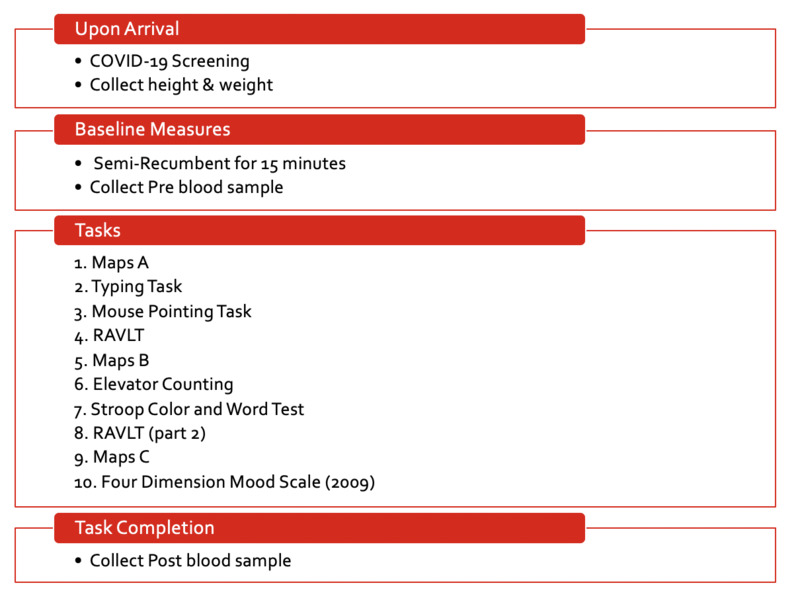Methodology
Participants
Healthy presenting subjects were recruited via word-of-mouth to participate in the present study. The demographic breakdown of the study participants is as follows: four men and one woman from the Ball State Community. Prior to participation all subjects were screened with a Physical Activity Readiness Questionnaire (PAR-Q+ 2014), indicating they were free from any known cardiovascular, pulmonary, or metabolic disorders. (1). The subjects indicated no medications were actively being taken that interfered with autonomic, metabolic, or cardiovascular function. All participants were able to walk unassisted on a treadmill. The female participant was required to experience a regular menstrual cycle for the past three consecutive months and was tested during the follicular phase of her menstrual cycle.
Experimental Design
Participants were asked to report to the Integrative Exercise Physiology Laboratory for two sessions of data collection with a total time commitment of roughly four hours. Prior to arrival the participants completed the Physical Activity Readiness Questionnaire, the International Physical Activity Questionnaire, and an informed consent form. Each session includes a before and after blood draw from an antecubital vein. Between the blood draws there were roughly 80-minutes of written, verbal, and computer tasks. During the tasks, the participant was either seated at a sedentary workstation or walking at 1-mile per hour at a treadmill workstation.
Blood Sampling/Processing
The whole blood samples immediately were used to analyze hematocrit using standard methods, and hemoglobin was computed by absorptions photometry (Hemopoint® H2, EKF Diagnostics; Boerne, TX). Following that, the blood was centrifuged for 20 minutes at 2,750xg at 4° C. The plasma was decanted from the red cells and centrifuged again for five minutes at 2,750xg at 4° C. All of the plasma samples were stored in aliquots in a freezer at -20° Celsius until assayed. Coagulation potential was analyzed by activated partial thrombin time (APTT), prothrombin time (PT), and plasma concentrations of factor VIII and fibrinogen using an automated coagulometer (Start4®, Diagnostica Stago, Parsippany NJ), in accordance with manufacturer guidelines.
Statistical Analysis
The statistical analyses were computed on SPSS for Macintosh (Version 27.0, 2020, Chicago IL). Height and weight were collected before each session. Clotting and hemodynamic parameters were collected before and after each session. Plasma samples were corrected for changes in plasma volume using the Dill & Costill method. Coagulation potential was determined by evaluating the following: activated partial thromboplastin time (APTT), prothrombin time (PT), factor VIII and fibrinogen levels. A two-way ANOVA was conducted using time (pre- and post) and condition (sitting, walking) as within-subjects factors for the coagulation variables. A one-way ANOVA was conducted to assess task performance. Significance level was set at p<0.05 (less than or equal to).
Workstations
Sedentary Workstation
- The sedentary workstation utilized in this study was a standard desk that had a computer monitor, keyboard and mouse. Once the participant was moved to the sedentary workstation, they remained seated for the duration of the study while performing the various tasks. When all tasks were finished, the equipment was removed, and the second blood draw took place at the sedentary workstation.
Treadmill Workstation
- The treadmill workstation in this study consisted of a height adjustable desk that was placed over a treadmill. The participant was moved to the active workstation and given time to acclimate to the walking speed of 1-mph. Once adapted, the participant walked for the duration of the study while performing the various tasks. When the tasks were finished, the equipment was removed, and the second blood draw took place while the participant was standing on the treadmill.
MAPS
The participant searched for a specific object for each version for two minutes on a map of Philadelphia. They changed markers after one minute. Measuring sustained and selective attention.
- Version A – Fork and Knife, Version B – Gas Pump & Version C – Wrench
Mouse Pointing
The Mouse Pointing task is a movement time evaluator that tested the ability of the participant to test their speed and accuracy of using a mouse.
Stroop Color and Word Test
There were words written in different colors on the computer screen. The goal of the Stroop Color and Word Test is to identify the color of the letters, not what the word says. There were 96 trials with a break built into the trials allowing the participant to take as much time as needed. This tasks measured accuracy and response time.
RAVLT
The Rey Auditory Verbal Learning Test (RAVLT) was an oral word memorization task. The participant was asked to recite the words they remember from a list of words read to them.
The second RAVLT task tested the participant on how many words they can remember from the first list of words that they heard from 20-minutes ago.
Elevator Couting
The elevator task challenged the participant to pretend they were on an elevator whose floor indicator is broken. They listened to pre-recorded tones to figure out what floor they are at with the elevator only going up. Measuring sustained and selective attention.










